Lordgizmo11
On this page, you find all documents, package deals, and flashcards offered by seller lordgizmo11.
- 264
- 0
- 1
Community
- Followers
- Following
2 Reviews received
265 items

Med Surg Final Exam ATI Questions
Application Exercises 1. A nurse is caring for a client who displays signs of stage III Parkinson’s disease. Which of the following actions should the nurse include in the plan of care? A. Recommend a community support group. B. Integrate a daily exercise routine. C. Provide a walker for ambulation. D. Perform ADLs for the client. 2. A nurse is developing a plan of care for the nutritional needs of a client who has stage IV Parkinson’s disease. Which actions should the nurse incl...
- Exam (elaborations)
- • 53 pages •
Application Exercises 1. A nurse is caring for a client who displays signs of stage III Parkinson’s disease. Which of the following actions should the nurse include in the plan of care? A. Recommend a community support group. B. Integrate a daily exercise routine. C. Provide a walker for ambulation. D. Perform ADLs for the client. 2. A nurse is developing a plan of care for the nutritional needs of a client who has stage IV Parkinson’s disease. Which actions should the nurse incl...

MED SURG FINAL EXAM S.G. BOLD ONES I GOT WRONG EXAM 1
MED SURG FINAL EXAM S.G. BOLD ONES I GOT WRONG EXAM 1 1. A nurse performs a skin screening for a client who has numerous skin lesions. Which lesion does the nurse evaluate first? 2. The nurse is caring for a client with an acute burn injury. Which action should the nurse take to prevent infection by autocontamination? 3. A client has a leg wound that is in the second stage of the inflammatory response. For what manifestation does the nurse assess? 4. A nurse is caring for a client with sy...
- Exam (elaborations)
- • 37 pages •
MED SURG FINAL EXAM S.G. BOLD ONES I GOT WRONG EXAM 1 1. A nurse performs a skin screening for a client who has numerous skin lesions. Which lesion does the nurse evaluate first? 2. The nurse is caring for a client with an acute burn injury. Which action should the nurse take to prevent infection by autocontamination? 3. A client has a leg wound that is in the second stage of the inflammatory response. For what manifestation does the nurse assess? 4. A nurse is caring for a client with sy...
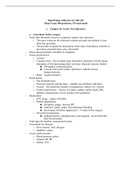
Final Points of Review for NR 120 Final Exam 100 questions; NO med math
Final Points of Review for NR 120 Final Exam 100 questions; NO med math 1. Chapter 18- Lewis: Pre-Operative a. Assessment before surgery - Verify that informed consent is completed, signed, and witnessed o The nurse witnesses the informed consent and make sure patient is clear about the procedure o The provider responds for description of the risks of anesthesia, benefits of procedure, potential harm, pain, discomfort - Ensure the preoperative checklist is completed - Assess psychosoc...
- Other
- • 25 pages •
Final Points of Review for NR 120 Final Exam 100 questions; NO med math 1. Chapter 18- Lewis: Pre-Operative a. Assessment before surgery - Verify that informed consent is completed, signed, and witnessed o The nurse witnesses the informed consent and make sure patient is clear about the procedure o The provider responds for description of the risks of anesthesia, benefits of procedure, potential harm, pain, discomfort - Ensure the preoperative checklist is completed - Assess psychosoc...
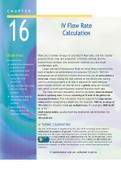
16_Curren_1401831222 - CHAPTER 16 Objectives IV Flow Rate CalculatioN
C H A P T E R 16 IV Flow Rate CalculatioN Objectives The learner will: 1. identify the calibrations in gtt/mL on IV administration sets 2. calculate flow rates using ratio and proportion 3. calculate flow rate using the rate formula method 4. calculate flow rates by the division factor method 5. recalculate flow rates to correct off-schedule infusions There are a number of ways to calculate IV flow rates, and this chapter presents three: ratio and proportion, a formul...
- Other
- • 19 pages •
C H A P T E R 16 IV Flow Rate CalculatioN Objectives The learner will: 1. identify the calibrations in gtt/mL on IV administration sets 2. calculate flow rates using ratio and proportion 3. calculate flow rate using the rate formula method 4. calculate flow rates by the division factor method 5. recalculate flow rates to correct off-schedule infusions There are a number of ways to calculate IV flow rates, and this chapter presents three: ratio and proportion, a formul...
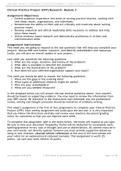
NRSE_4600_M3_A6_WA_TEMPLATE_Clinical Practice Project (CPP) Research: Module 3
Clinical Practice Project (CPP) Research: Module 3 Assignment Objectives: • Extend academic experience into areas of nursing practice interest, working with new ideas, issues, organizations, and individuals. • Demonstrate the ability to think and act critically and creatively about nursing practice issues. • Develop analytical and ethical leadership skills necessary to address and help solve these issues. • Utilize evidence based research and demonstrate proficiency in written an...
- Other
- • 10 pages •
Clinical Practice Project (CPP) Research: Module 3 Assignment Objectives: • Extend academic experience into areas of nursing practice interest, working with new ideas, issues, organizations, and individuals. • Demonstrate the ability to think and act critically and creatively about nursing practice issues. • Develop analytical and ethical leadership skills necessary to address and help solve these issues. • Utilize evidence based research and demonstrate proficiency in written an...
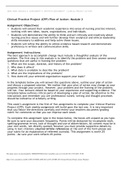
NRSE_4600_M2_A4_WA_TEMPLATE_Clinical_Practice_Project_Action_: Module 2
Clinical Practice Project (CPP) Plan of Action: Module 2 Assignment Objectives: • Students will extend their academic experience into areas of nursing practice interest, working with new ideas, issues, organizations, and individuals. • Students will demonstrate the ability to think and act critically and creatively about nursing practice issues and will further develop their analytical and ethical leadership skills necessary to address and help solve these issues. • Students will ref...
- Other
- • 9 pages •
Clinical Practice Project (CPP) Plan of Action: Module 2 Assignment Objectives: • Students will extend their academic experience into areas of nursing practice interest, working with new ideas, issues, organizations, and individuals. • Students will demonstrate the ability to think and act critically and creatively about nursing practice issues and will further develop their analytical and ethical leadership skills necessary to address and help solve these issues. • Students will ref...
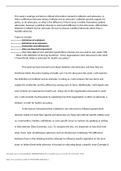
NRSE 4600 D3.docx - This weeks readings and lecture offered.
This week’s readings and lecture offered information related to lobbyists and advocates. Is there a difference between being a lobbyist and an advocate? Lobbyists provide support for policy, as do advocates, so what is the difference? Most nurses consider themselves patient advocates; however a political advocate is somewhat different. In this discussion, differentiate between a lobbyist and an advocate. Be sure to discuss a political advocate rather than a bedside advocate. Topics to inclu...
- Other
- • 3 pages •
This week’s readings and lecture offered information related to lobbyists and advocates. Is there a difference between being a lobbyist and an advocate? Lobbyists provide support for policy, as do advocates, so what is the difference? Most nurses consider themselves patient advocates; however a political advocate is somewhat different. In this discussion, differentiate between a lobbyist and an advocate. Be sure to discuss a political advocate rather than a bedside advocate. Topics to inclu...
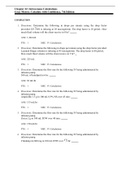
Chapter 22: Intravenous Calculations Gray Morris: Calculate with Confidence, 7th Edition
Chapter 22: Intravenous Calculations Gray Morris: Calculate with Confidence, 7th Edition COMPLETION 1. Directions: Determine the following in drops per minute using the drop factor provided. D5 NS is infusing at 28 macrogtt/min. The drop factor is 10 gtt/mL. How much fluid volume will the client receive in 8 hr? 2. Directions: Determine the following in drops per minute using the drop factor provided. Lactated Ringer solution is infusing at 45 microgtt/min. The drop fac...
- Exam (elaborations)
- • 10 pages •
Chapter 22: Intravenous Calculations Gray Morris: Calculate with Confidence, 7th Edition COMPLETION 1. Directions: Determine the following in drops per minute using the drop factor provided. D5 NS is infusing at 28 macrogtt/min. The drop factor is 10 gtt/mL. How much fluid volume will the client receive in 8 hr? 2. Directions: Determine the following in drops per minute using the drop factor provided. Lactated Ringer solution is infusing at 45 microgtt/min. The drop fac...
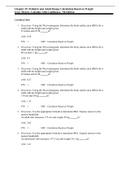
Chapter 25: Pediatric and Adult Dosage Calculation Based on Weight Gray Morris: Calculate with Confidence, 7th Edition
Chapter 25: Pediatric and Adult Dosage Calculation Based on Weight Gray Morris: Calculate with Confidence, 7th Edition COMPLETION 1. Directions: Using the West nomogram, determine the body surface area (BSA) for a child with the height and weight given. 32 inches and 25 lb: m2 2. Directions: Using the West nomogram, determine the body surface area (BSA) for a child with the height and weight given. 80 cm and 11 kg: m2 3. Directions: Using the West nomogram, determine the body ...
- Exam (elaborations)
- • 12 pages •
Chapter 25: Pediatric and Adult Dosage Calculation Based on Weight Gray Morris: Calculate with Confidence, 7th Edition COMPLETION 1. Directions: Using the West nomogram, determine the body surface area (BSA) for a child with the height and weight given. 32 inches and 25 lb: m2 2. Directions: Using the West nomogram, determine the body surface area (BSA) for a child with the height and weight given. 80 cm and 11 kg: m2 3. Directions: Using the West nomogram, determine the body ...
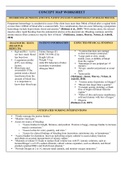
Fatime Sanogo CONCEPT MAP WORKSHEET DESCRIBE DISEASE PROCESS AFFECTING PATIENT (INCLUDE PATHOPHYSIOLOGY OF DISEASE PROCESS)
CONCEPT MAP WORKSHEET DESCRIBE DISEASE PROCESS AFFECTING PATIENT (INCLUDE PATHOPHYSIOLOGY OF DISEASE PROCESS) Postpartum hemorrhage is considered to occur if the client loses more than 500ml of blood after a vaginal birth or more than 1,000ml of blood after a cesarean birth. Two complications that can occur following a postpartum hemorrhage include hypovolemic shock and anemia.” (Holman et al., 2019) “With uterine atony, the relaxed muscles allow rapid bleeding from the endometrial arterie...
- Other
- • 12 pages •
CONCEPT MAP WORKSHEET DESCRIBE DISEASE PROCESS AFFECTING PATIENT (INCLUDE PATHOPHYSIOLOGY OF DISEASE PROCESS) Postpartum hemorrhage is considered to occur if the client loses more than 500ml of blood after a vaginal birth or more than 1,000ml of blood after a cesarean birth. Two complications that can occur following a postpartum hemorrhage include hypovolemic shock and anemia.” (Holman et al., 2019) “With uterine atony, the relaxed muscles allow rapid bleeding from the endometrial arterie...

6.1.3_Final_Exam__Semester_2_Exam 2023 complete with correct answers 100%
6.1.3_Final_Exam__Semester_2_Exam 2023 complete with correct answers 100%
Yooo
Translated by Google